| |
On Toji, the winter solstice, the Japanese greet the end of darkening days with traditions aimed at improving health. Grocery stores are filled with yuzu, a small yellow citrus fruit with a taste and aroma similar to grapefruit. It is traditional to toss a few yuzu into the ofuro, allowing you to relax in a hot bath surrounded by the fragrant oils. Similarly, eating kabocha (Japanese pumpkin) on the solstice is believed to prevent colds in the coming year. We celebrated Toji by mixing traditions ¡½ and cocktails. An acquaintance had gifted us with a kabocha some time ago, so we simmered it for dinner with some fresh ginger (given our track record, we're all about combining as many cold-prevention ingredients and traditions as possible). We filled our ofuro with sliced yuzu for a refreshing end to a difficult week. And, we shook yuzu juice with gin and Cointreau in a celebratory cocktail, raising our glasses to the return of light and the prospect of good health in the coming year.
We've both been here long enough to have unusual experiences and eat unusual things. On the eating front, they've almost always been things we've chosen to eat ¡½ nobody really springs freaky stuff on the unsuspecting gaijin. For example, one night at Hige-oyaji's place, he started showing us some more adventurous Japanese foods, including hizunamasu, a Hokkaido regional specialty. Hizunamasu is thin slices of pickled salmon head, cartilage and all. I rather liked it; it makes a nice accompaniment to a mug of beer. He also showed us his big jar of shiokara, which Wikipedia defines as "small pieces of the [sea] animal's meat in a brown viscous paste of the animal's heavily salted, fermented viscera." It's frequently served with shots of sake, perhaps to no one's surprise after that description. We'd gone there a number of times before that night, so we assumed that he'd only busted out the potentially yak-inducing fish preparations because he knew us well enough to know that we wouldn't gag or otherwise freak out. So it was with little or no trepidation that we visited a new-to-us fish restaurant earlier this week. The owner/chef had a pretty standard set of dishes on his menu: nabe teishoku (hotpot served with rice, pickles, and another side of some type); grilled fish teishoku (same thing, but with grilled fish in place of the hotpot and with miso soup); fried fish, maybe an oyster stew. Matthew ordered the seafood nabe teishoku, I went with grilled fish. Things were proceeding as they usually do until we were served. Then the following conversation took place: MAD: I don't know how to eat a whole fish head. SKD: Oh, farm. Is that shiokara? Indeed, on our trays sat little bowls of shiokara, apparently a standard teishoku dish at this restaurant. We ate our other things, glancing at the ruddy brown dish every now and again. Finally, we each bit the bullet and tried it without the benefit of sake because we still had work to do. And. . . it wasn't half bad ¡½ it was quite salty, and tasted rather like fishy miso with bits of squid in it. Mostly, it was a good reminder of what should be the motto for our lives here: expect the unexpected.
Technology at work on the mailbox outside JR Mizusawa Station: 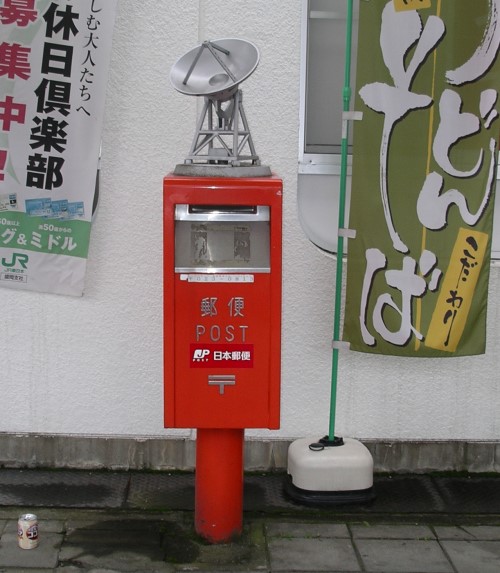 It's actually a model of a radio telescope, presumably to recognize Mizusawa's status as host to one of the radio telescopes in the VERA network. I prefer to think that Japan Post Service simply beams mail out of the box to wherever it needs to go.
Thursday, December 20, 2007, 2:51 PM GeneralPosted by matthew How big do snowflakes get? I mean a single six-pointed lacy bit of ice, drifting down from the sky. When you see big snowflakes coming down, they're not just a single snowflake: each fluffy white "flake" is really a clump of small snowflakes and snowflake parts.
My morning walk with the dogs started with overcast skies, but no precipitation. A few minutes into it, a big snowflake fell near Moki. It seemed a little odd, as it was the only one. I wondered if it had fallen from a tree or something, but there was nothing near. Then a few seconds later, I saw another one. Gradually, more of them began to fall, but it was still an interesting combination of large but very sparse snowflakes.
Then, one landed on my coat where I could get a good look at it. It was one large, intact, snowflake, about half an inch across. A couple of smaller snowflakes (maybe an eighth of an inch) had stuck to it, but didn't hide or damage its delicate structure. It's one of the most amazing things I've ever seen. I spent the rest of the walk catching snowflakes to try to find another one — but all I could get were clumps of small snowflakes and snowflake parts jumbled together.
[ 4 comments ] permalink
Losing My Mind (Among Other Things)
Thursday, December 20, 2007, 1:22 AM GeneralPosted by stefanie It's been a tough couple of weeks for relatively valuable items here at Let's Sharing HQ. Between last week's lost wallet and yesterday's lost car key, we've spent a goodly amount of time retracing our steps (fortunately, Kitakami isn't that big) and revisiting establishments in search of our missing items. And I've become quite proficient at filing lost item reports in Japanese, which is the bright side here. Isn't necessity the mother of language learning? I think I heard that somewhere.
Today's chapter in the lost key saga found me at a small key shop located inside a kitchen supply store, run by an old, weathered Tohoku-jin. Our conversation required patience on both sides: for him, because I need a fair amount of repetition, slow talking, and cognition time before I can understand something, and for me because he spoke with a thick accent and the low, mumbly speech frequently used by older northern Japanese men. And he had a boatload of customers coming in and out, including another guy with a thick accent and mumbly speech. They had a long conversation about something while I waited, drooling over the Japanese knives; for all I know, they were talking about the Amerika-jin with negligible language skills needing a hard-to-make key for a German car.
At any rate, we weren't able to work out a keymaking arrangement today, so he asked me to come back tomorrow. I can't make it, so I offered up Matthew as a substitute with the assurance that he speaks better Japanese than I do. In retrospect, I think I actually told him someone's dad would be coming. Oops.
[ 6 comments ] permalink
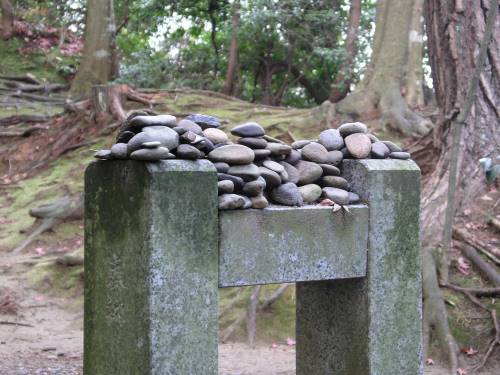 Chusonji is a famous temple in Hiraizumi, about 40 minutes south of Kitakami by car or train. It is most famous for the large main hall and the opulent Konjikido (golden hall) covered in gold leaf and mother-of-pearl inlay. Less well known are the dozens of smaller halls and shrines dotting the grounds. In many places, any horizontal surface has pebbles piled on it. The piling of stones seems to be a sort of prayer enhancement: you make your prayer, then stack stones up towards the heavens. The higher you can stack them, the better.
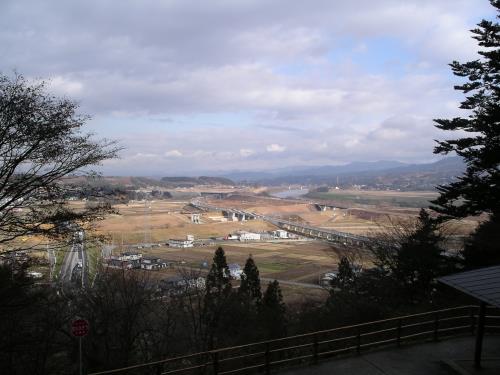 Hiraizumi Hiraizumi is a major historical attraction of Iwate, and the site of Chusonji, the first temple designated as a National Treasure of Japan. The temple is built on a forested hill, where occasional breaks in the trees offer views like this.
[ 2 comments ] permalink
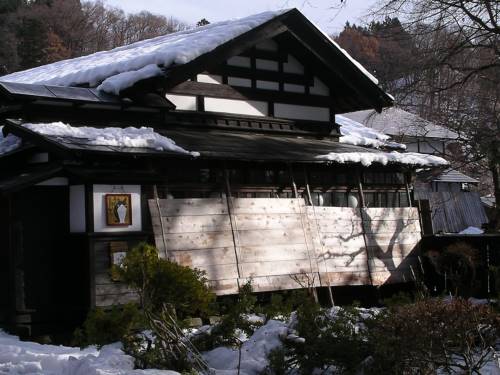 The border between Iwate and Akita runs along the central mountain ridge of Japan, with Iwate on the east and Akita on the west. Cold air from Siberia picks up moisture crossing the Sea of Japan, then socks Akita with deep "lake effect" snows. Iwate is protected by the mountain ridge, so it gets far less snow even though it's right next door. One indicator of this difference is that on the Akita side, many houses' first floor windows and walls are protected by additional boards in winter. They are set against the houses to keep the snow from pushing directly on the walls and damaging them.
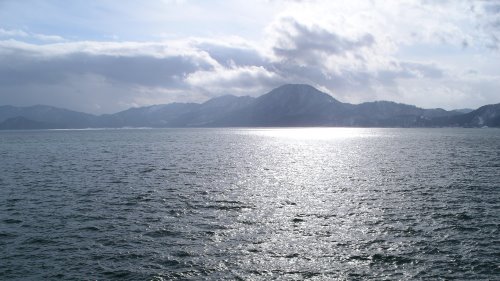 Lake Tazawa, the deepest lake in Japan, is in Akita Prefecture and not too far from the Iwate border. We remember it well from our 2006 visit, and went to see it again last week. It's definitely the off-season — there was hardly anyone else there, and many of the shops and kiosks were closed — but the cold winter air and the snow made for a beautiful sight.
To: Matthew and Stefanie From: Moki and Aki Re: ZabutonsBecause we are Japanese dogs, we believe we should get to use the zabutons. Aki wants the red one. She also wants the kotatsu. 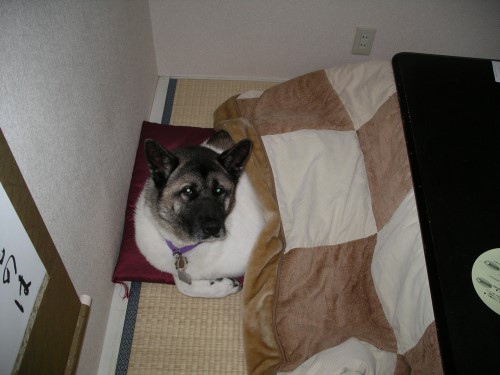 Also, Moki would prefer something a little larger. 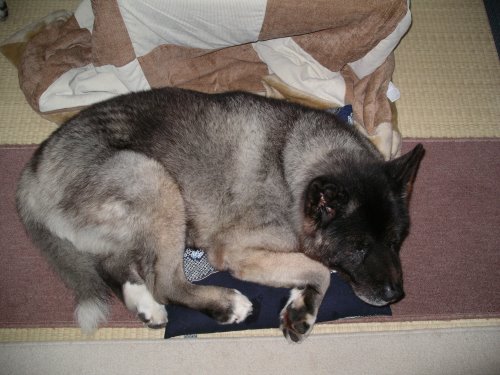 Thank you.
Back Next
|
|







 Calendar
Calendar




